Campaign History of the 151e Régiment d'Infanterie - XVII
~ 1916 ~
The Somme - First Tour - (20-29 September)
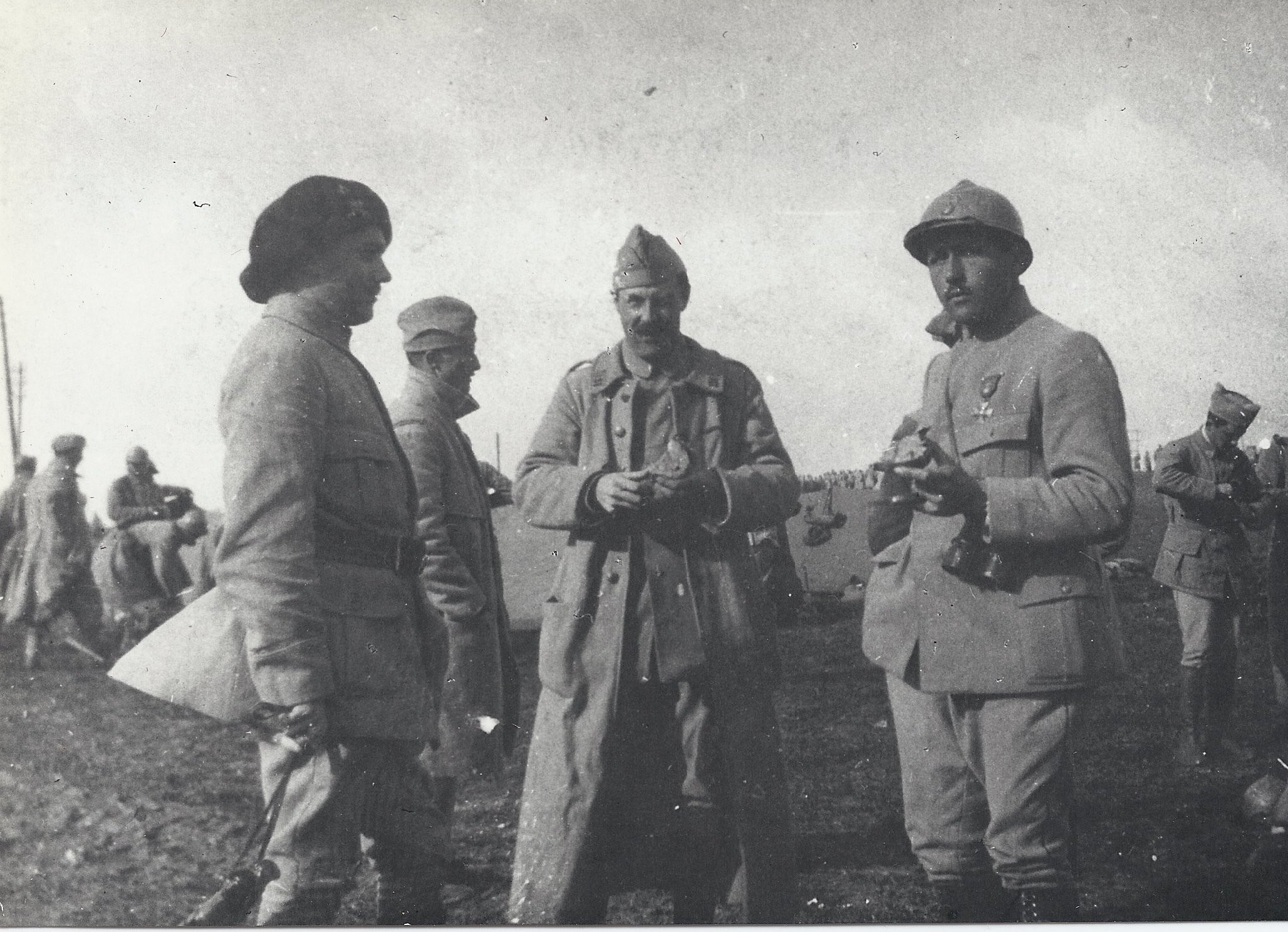, Bourgoin, de la Ferriere, Platte - Bray-sur-Somme - 24 Sept 1916.jpg?dl=0)
Sous-Lieut. Dusmenil (9 Co.), Lieut. Bourgoin (10 Co.), Sous-Lieut. de la Ferrière (10 Co. - KIA 6 June 1918), and, in right background, Sous-Lieut. Platte (10 Co.) at Bray-sur-Somme - 20 Sept. 1916. Photo taken by Tison.
20-24 September: On 20 September, the 151 -- roughly 2,070 strong -- once again climbs up into trucks that will take them to Maricourt. From there, it will march the rest of the way up to the front lines once night falls. The relief march will prove to be a difficult one. Torrential downpours transformed the trenches into a quagmire of knee-deep mud. Each step forward became its own effort as the heavily-laden men had to pull their feet out of the sucking-mud. Progress can be made only very slowly and with great expense of energy. The units only arrive to their assigned positions in the early morning hours of 21 September, where they relieve the 13 and 53 BCAs.
The trenches they occupied faced northeast toward the village of Rancourt and its accompanying cemetery. The left limit of the regiment's subsector was the intersection of the Rancourt - Cemetery road and the Ferme le Priez road. The 127 RI was in liaison to the left. The right limit of the subsector 300 meters to the east of the Rancourt - Le Forest road. The 94 RI was in liaison to the right. The 1 Bat. was placed on the left, the 3 Bat. on the right, and the 2 Bat. was in support.
Meanwhile, Aspirant André L'Huillier who had returned to the regiment on the 19th following his officer training program (Ecole Spéciale Militaire de Saint-Cyr), was assigned to 6 Co. (commanded by Lieut. Bastaud) and placed in charge of 1e Section. L'Huillier was happy to find lieutenants Bourgoin and Donsimoni along with a few men from his days in the Argonne still in the ranks. Morale was high, the feeling of confidence that had been crushed under the shells of Verdun, had at last returned.
Lots of activity with the 2nd Battalion: grenade throwing exercises, manner for employing gas masks, detail reviews. A surprise: the Commandant has decided that the foot-soldiers will attack with blankets rolled in bandolier fashion, two haversacks with grenades and reserve rations, etc., so as to allow for greater freedom of movement on the terrain and facilitate the advance. Packs will be left with the rear-echelon units. We have strong hope in a breakthrough at last of the enemy front and to exploit the success!
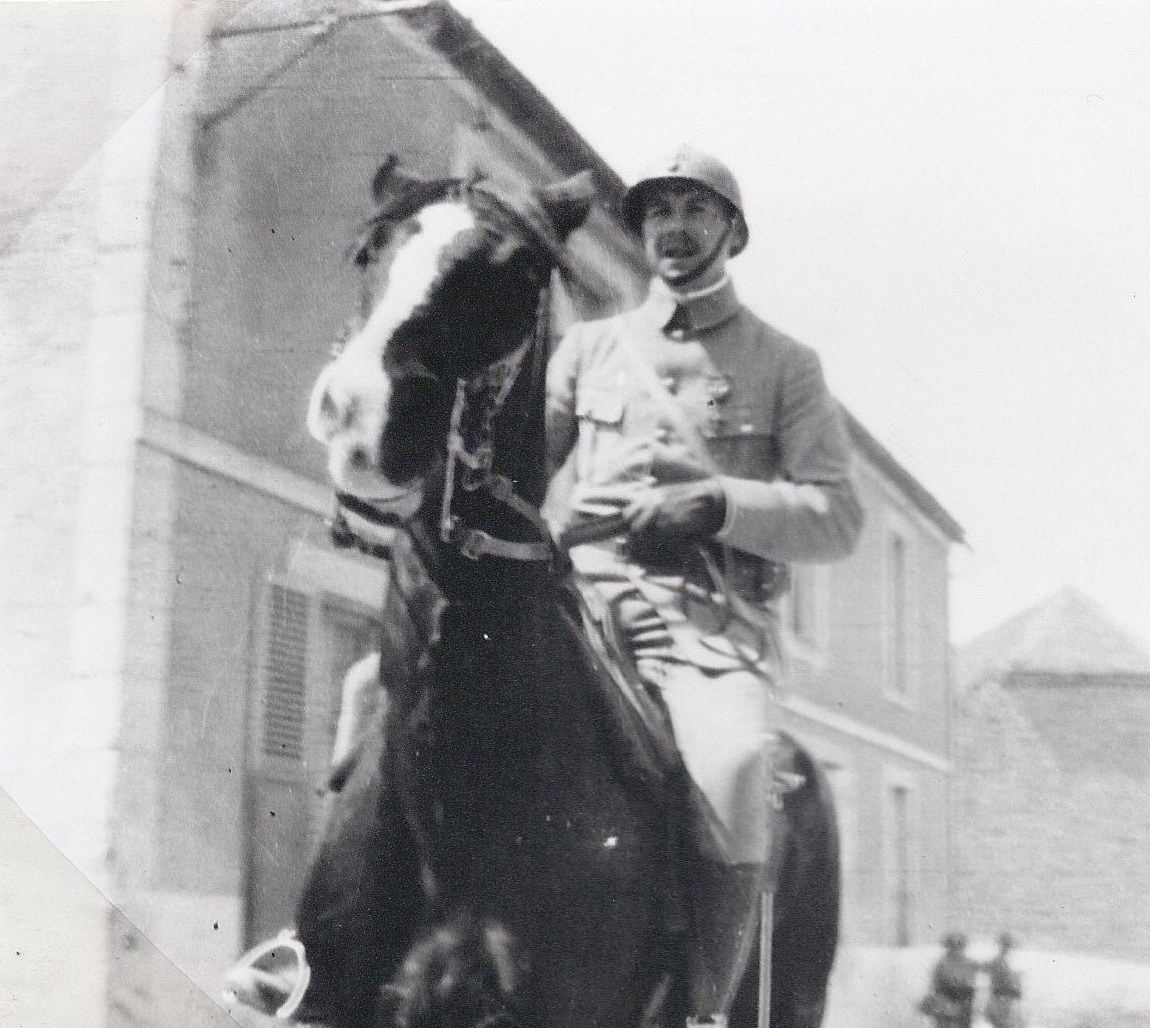
Lieut. Bastaud (6 Co.) in 1917. Photo taken by L'Huillier.
L'Huillier and his company commander also demonstrate excellent leadership skills when an incident unfolds that could easily have taken a dark turn.
The 151 was entering a hot sector to be sure. While they were struggling in the night through the mud-filled communication trenches, the Germans had launched a strong infantry attack against Rancourt and its cemetery. Though the enemy assault waves were hammered by French artillery as they advanced, in some places the attackers made it as close as 20 meters from the French line. Hundreds of poilus and chasseurs are killed or wounded, yet in the face of the withering French rifle and machine-gun fire they are repulsed with very heavy losses. German artillery retaliates by laying down a heavy bombardment on the French lines. Sdt. August Bordinat was with 6 Co. (2 Bat.) and recorded on 20 September:A poilu from the 4th Section, Soldat Jean-François Quegnies [possibly a pseudonym], who had recently arrived to the regiment, breaks two rifles in the weapons rack. "I don't want to go and fight, I'm afraid, I want to be arrested, taken to prison, to the rear," etc., etc. Lieutenant Bastaud, informed of the issue, tries to reason with him, surrounded by his soldiers with whom he has a good understanding. Our company commander told him, "Calm down, I won't punish you, I'm transferring you to another section. You'll have a young leader who you'll get along with, I hope: Aspirant L'Hullier right here." After consultation, I had agreed to take this "griper" under my command, to the great astonishment of my men. The night passes and to bolster Quegnies' confidence, I decide to make him my orderly, mine who had fallen ill and having just been evacuated. Can we guess his astonishment? I tell him the reasons why I volunteered at the age of 18. He is now executing my orders correctly and is getting ready just like his comrades to go up into line shortly.
Throughout the afternoon and evening of 21 September, the German bombardment of the regiment's lines increases in intensity. The men pass the day working to organize their positions. This work continues into the next day. During the night of 22 September, departure parallels (jumping-off trenches) are dug in preparation for an attack to be carried out by regiment the next day (23). It's objective will be the village and cemetery of Rancourt and the adjacent enemy trenches. Losses for the regiment on 22 September include 5 killed and 35 wounded.From Maricourt, to go up into line, as always we march the rest of the way where, after a thousand small adventures, we arrive at one o'clock in the morning to relieve the 25th Battalion de Chasseurs à Pied [most likely the 53 BCA instead] in front of Rancourt, on the road from Bapaume to Péronne. We are facing the cemetery which is our mission to take once the order is given. We therefore stayed in place for a few days and, at night, went to look for our supplies at Maurepas or Leforest, of which not a stone marker could be found and the real look of Verdun strikes us again. The thirst was not so strong, as were are able to drink the greenish water from the shell-holes close to us.
The next day, French artillery becomes very active without much response from the German side. The attack which was slated to be launched this day is instead delayed due to the bad weather and what is judged to be inadequate results at certain points from the preparatory bombardment. To Laporte, the most difficult thing was simply getting around in the mud during munitions and ration resupply fatigues. "The stagnant, liquid mud -- which emitted a foul odor -- turned the shell-holes into lakes and half-submerged the trenches."
At night, work continues on improving the trenches and in further digging the departure parallels. Losses for the regiment on 23 September include 3 killed and 11 wounded. The next day is spent in the same way: making preparations for the impending attack which is now scheduled for 25 September.
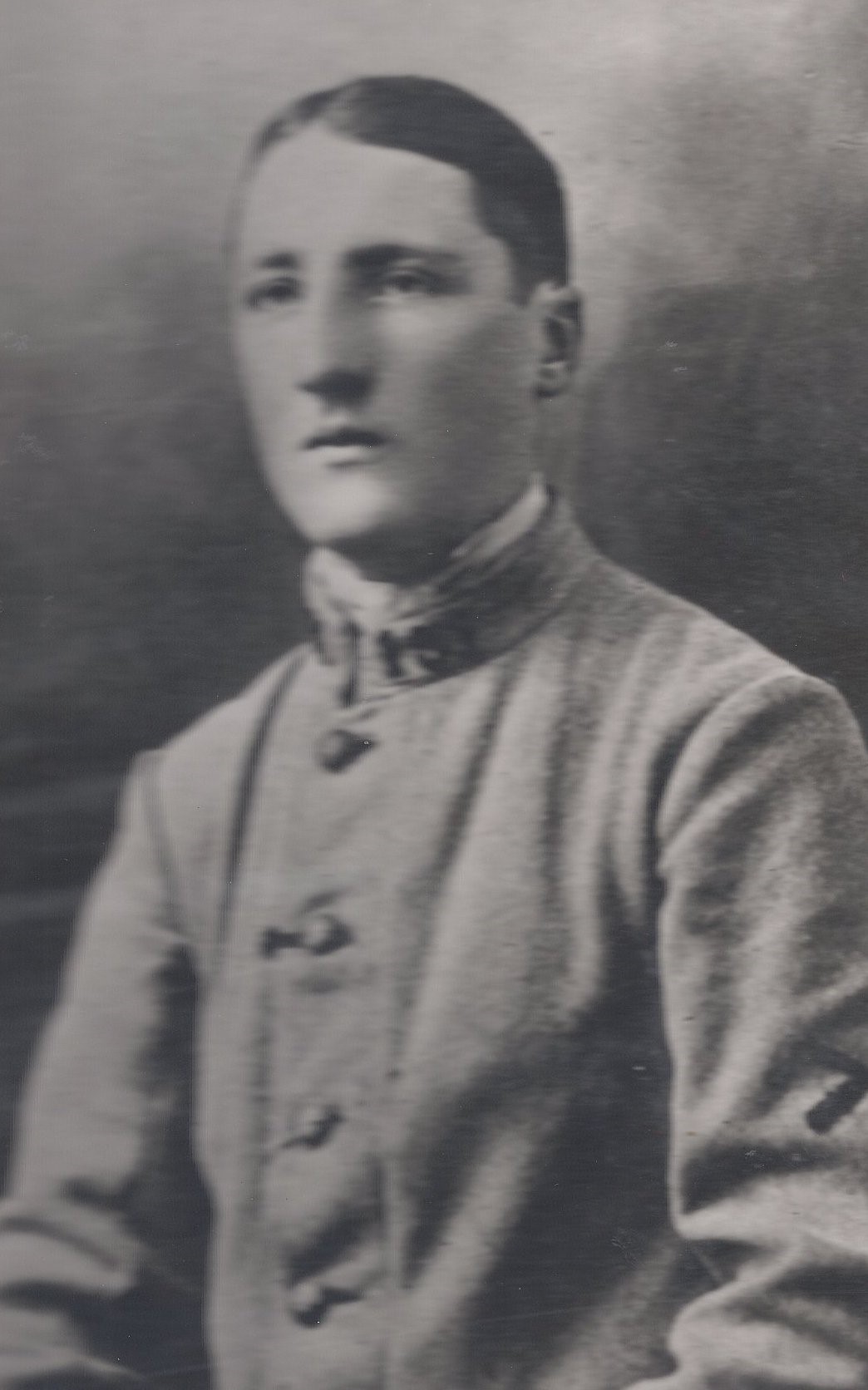
Cpl. Paul Joseph Fournier (KIA 25 September 1916).
The final days of 20-year-old Cpl. Paul Joseph Fournier, class 1916, were recorded in his letters home:
This was Cpl. Fournier's last letter home. He would be killed in the attack the following day. On 23 September, L'Huillier recounted the pep talk Lieut. Bastaud gave to his four section leaders upon his return from 2 Bat. HQ. Here is a summary of what Bastaud's words:22 September 1916:
A couple words as I promised to you. I am in the trenches or rather in a shell-hole to the right of Combles since the night of the 20th-21st. The bombardment of the enemy lines is terrible. We suffer much less. Besides, I'm filled with much confidence on this occasion. I don't know how long we'll be here, but not long for sure. Will write to you again as soon as possible. Giving you a big hug.23 September 1916:
I'm taking advantage of a moment of calm given to us by the Boches to reassure you that my health is still good. As I wrote to you yesterday, we went up on the night of the 20th-21st. It is therefore the third day today and not the fourth as you may think after my letter of the 19th. On more day in the rear and on the 20th we headed up to the front in deplorable weather. After a journey of 10 or 12 kms in cars, we disembarked at the point of where we'd advanced the frontline before the July offensive.We have a meal on the spot and are provided with additional reserve rations, then set out in 25 cm (10") thick mud. I assure you that this relief was extremely tiring, for we were already exhausted by two days spent in the rear carrying and bringing back cases of ammunition. We passed through villages recaptured from the enemy and were able to judge the effect of our bombardment. It's the worse I've ever seen outside of Verdun. You can say that no stone has been left unturned. Everything is flattened. There are craters dug out by at least 400s [mm shells]. Our positions are as they so often are nothing more than shell holes, but the enemy artillery is much weaker than ours.
This is revenge for Verdun. What the Boches received on the 21st is unheard of. Some forced to leave their positions, fled into open ground, pursued by our 75s [mm cannons] or our rifle fire. I saw a wounded man fall, get back up and finally collapse dead. It's not pretty. At last it's their turn.
Here because of the battles which took place before our arrival, there is a quantity of Boche equipment objects, enough to fill up a whole museum if was possible to send to you. Resupplying is very difficult and you have to go find it 8 or 9 km away from here by making your way along with no clue where to go.
The most frustrating thing is the question of water. As we are not brought any, we have to go to look for it at night in the shell-holes. The little tablets you sent me while I was at Mort Homme have served me well. If you can send me as soon as possible a Cadum soap, a new tube of white tablets and [illegible] 60 tablets like you sent me before to sterilize the water. Since the evening of the day before yesterday, the weather turned good again and that of course brought back good spirits in spite of everything.
I have more confidence than ever. Moreover, we're not going to be here very long. The time has come for the Boches to get beaten and we will soon have earned us a break. Above all, don't worry too much. Say hello to everyone or me. Giving you a big hug. Unshaven, covered in mud or dust from head to toe. I think we would be a sad spectacle if we were dropped into Paris looking like this.
24 September 1916:
I am still in good health and in the trenches. I hope you are doing much better on your side. The weather is still wonderful today. We have to hope that this won't last much longer. Don't be worried. Besides, you see that I do my best to make sure you hear from me. A big hug for all four of you.
By 24 September, the bombardment that had been growing steadily in intensity over the last few days had achieved in Laporte’s mind a level of intensity equaling that of Verdun. By 0100 hrs on September 25, it was an uninterrupted roar of passing shells and explosions, as flares shot up continually on both sides of the line. The regiment took casualties particularly in the reserve trenches, as the German artillery tried to block any movement of reinforcements. Losses for the regiment on 24 September include 9 killed and 40 wounded. Capt. Adj. Major Delavaivre takes command of 3 Bat. in replacement of Cmdt. Baudin who is evacuated."The French and English Armies will retake the offensive. Our regiment's mission is to take the heavily fortified village of Rancourt and subsequently the trenches known as "Portes de Fer" ["Iron Gates"] and "Prilep" that stretch out across the counter-slope along the border of the Saint-Pierre Wast woods and La Haye woods. See on this map the first objectives. Our departure base cuts across the Bapaume road about 600 meters from Rancourt. We will take it following night. Rancourt will be flattened by a violent artillery preparation as there are reinforced concrete shelters there. The English will attack on our left. No questions?...Well my dear friends, I trust you all as I have in the past. We are ready, physically and mentally. As for me, I am delighted at the thought of sporting for the first time my new stripes for this liberating offensive on the Somme!"
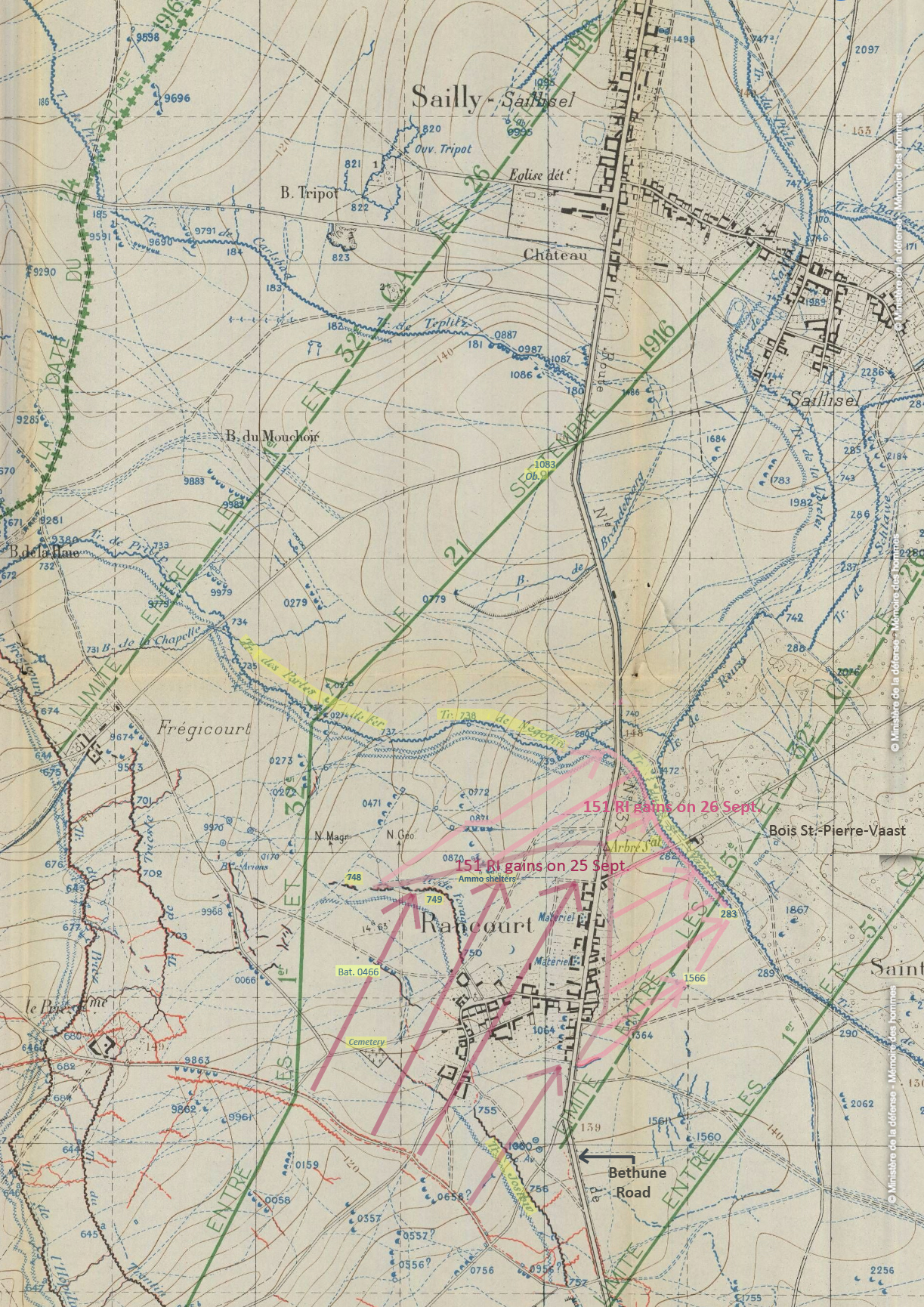
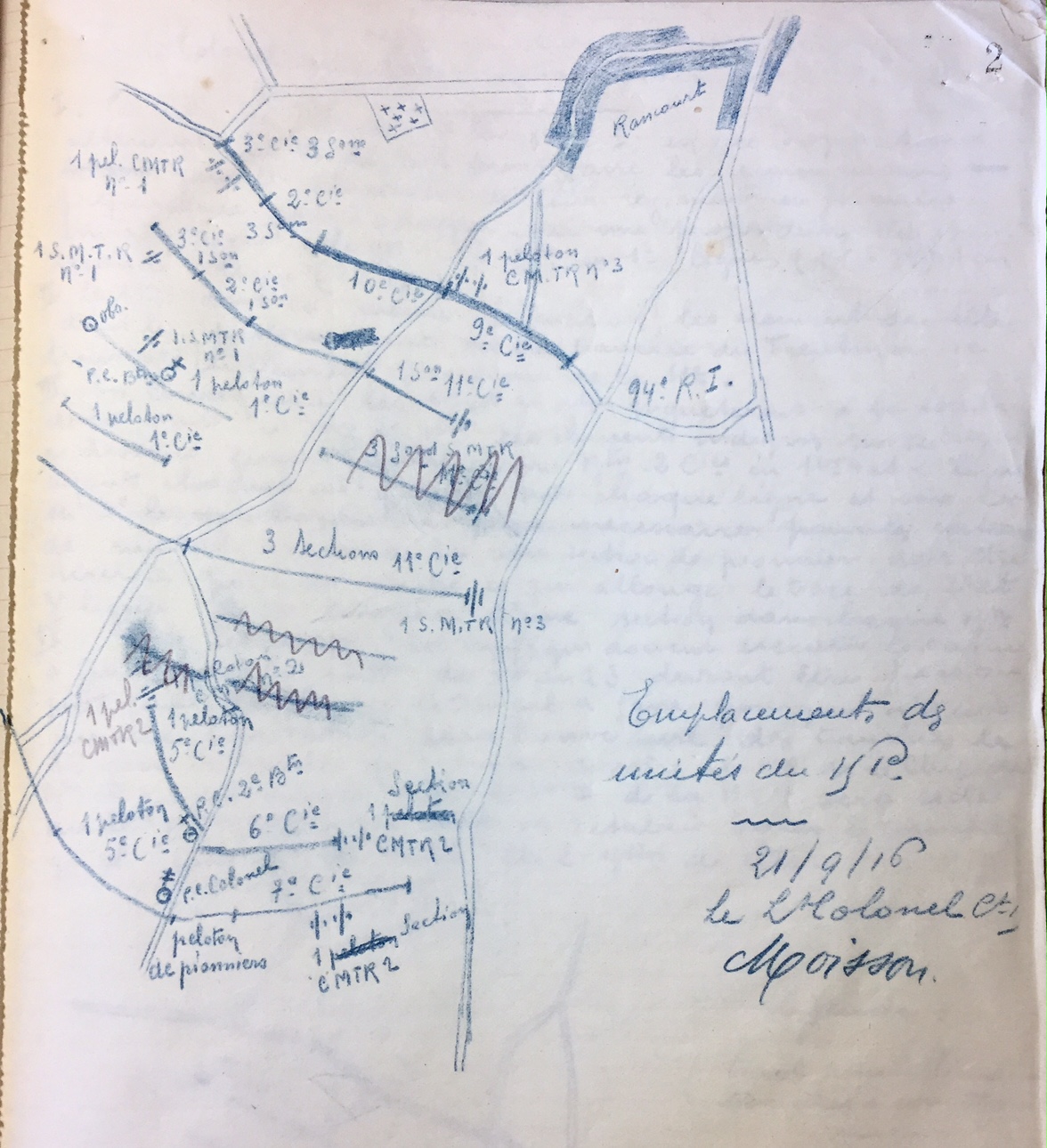
Left: Map of the Rancourt sector showing the disposition of units of the 151 on 21 September. Right: Map of the Rancourt sector on 21 September 1916. Positions of interest (objectives) have been highlighted in yellow. Rough directions and limits of the advances made by the 151 RI are shown in pink. A link to the original AFGG map can be found here.
Order of Operations for 25 September
I. Mission: Attack in the general direction of Sailly-Saillisel (north) in liaison to the right with 83 BI (94 RI, 8 BCP), to the left with 1 DI (127 RI), which will attack in the direction of Ouvrage Tripot.
II. Zone of Action of the Regiment: The regiment’s limit along with the 127 RI is demarcated by the line 648, 645b, intersection 162, 748, 274, intersection 100 meters east of Ouvrage Tripot.
The limit between the 151 and the 94 RIs is demarcated by the line 650b, Côte 146, branch of the Le Priez – Bouchavenes Road, from the dotted line coming from Rancourt (coordinated at 658), the intersection of the East-West street of Rancourt with the meridian 41, western edge of the Verges, to the west of the north end of Rancourt (this border to the 83 BI), point 741 (Portes de Fer trenches), Sailly-Saillisel path to Rancourt (this path to 83 BI).
III. Conditions of the Attack: The attack will be done by brigades accoladed to the right by 83 BI (94 RI, 8 BCP) and to the left by 84 BI (151 and 162 RIs). The 16 BCP is in reserve of the 42 DI. The 84 BI will operate in depth with the 151 RI in the first line, the 162 RI in the second line. The 151 will be disposed in the following fashion: 1 Battalion (Cmdt. Oblet) to the left, 3 Battalion (Cpt. Delavaivre) to the right, 2 Battalion (Cmdt. De la Ruelle) in support.
IV. Placement of the Regiment on the Terrain:
The 2 Battalion will be placed on the terrain in two lines, which will form at the departure the 4th, 5th and 6th waves. The placement by the 4th and 5th lines formed by the 2 Battalion, before the departure it will take up the following way: the three companies of the battalion arranged by half-companies by the 5th and 6th lines.
The companies on the wings comprising each a section of machine-guns in the 5th line, that in the center two sections of machine-guns. If the third 37 mm cannon, remain joined in dispersed fashion, will also place itself in the center company (6th line). Additionally, each of the companies on the wings will include a section of trench-cleaners (5th line). The company in the center will include a section of regimental pioneers (6th line).
At the moment of departure for the attack, the 2 Battalion will march with its two companies on the wings at the lead, forming the 4th and 5th wings, the company in the center will pass through to form the 6th wave, due to a platoon behind the lead companies, the pioneers marching with the right platoon.
V. Successive Objectives:
1. The cemetery, the cluster of houses south of Rancourt and the north section of Tranchée Jostow.
2. The battery 466 and the northern edge of the west side of Rancourt
3. Tranchées 748 and 749 (Tranchée Foragas), and the ammunition shelters
4. Portes de Fer trenches
5. Top of the observatory 1083
6. Sailly-Saillisel
Map of Rancourt sector showing the positions of the 151 RI and other units in the afternoon of 25 Sept. 1916 prior to the advance of 2 Bat., from the 151 JMO.
VI. Execution of the Attack: At l’heure H (“zero-hour”): depart. The 151 RI will seize the first three objectives in a single bound with the resources of 1 and 3 Battalions. In principle, each battalion leader must retain in hand a half-company and a section of machine-guns to parry any likely counter-attacks on the flanks.
When these objectives are reached, the first two battalions will install themselves and report. Once sufficiently installed in the conquered positions, the battalion leaders will demarcate to the artillery to lift their protective barrage fire in front, in accordance and coordination with each other and the regimental commander.
The 2 Battalion, which must remain closely behind the battalions of the first attack line, will pass through them and carry out a reconnaissance in force toward the 4th objective, getting a foothold and strongly organizing it.
The 162 RI, which in its advance will have successively taken the place of the various echelons of the 151, will seize in its turn the Portes de Fer trenches, ultimately getting a foothold on the top of observatory 1083.
VII.: After taking the Tranchées 748 and 749 and ammunition shelters, Cmdt. Oblet will designate a section of the Engineers Company 6/3 bis to return to help organize things into a defensive state, in liaison with the divisional engineers, which will be taking the village of Rancourt.
VIII.: Engineers Company 6/3 bis (Capt. Roy) put at the disposition of the 151, will bring the crates of cheddite to the PC of the 83 BI needed for making charges intended for blowing up enemy obstacles and to reestablish communications in the village of Rancourt. Ulteriorly, it will establish the communications between the 3rd and 4th objectives (putting them in place along the Bethune Road) and contribute to the changing over the Portes de Fer trenches into defensive positions.
IX.: Colonel Deville commanding the 84 BI emphasizes the importance of tactical liaison between the neighboring units. In order to take the successive objectives, it is advised to maneuver by the left, notably for the first three objectives.
The 42 DI observation plane (Farman model) will carry two flames and will signal with a two-fire flare. The artillery will detach to each of the battalions in the first line of attack an officer or aspirant with the standard liaison staff and material. The battalions of the first line will be connected directly to the commander of the artillery group operating to its front.
The first line emplacements will be marked by means of Bengale (Ruggieri) pots, light projectors, or absent these, drop cloths by a company at zero-hour 15’, recurring every 15 minutes, and also upon request by airplanes. The officers are reminded of the importance of marking out the line for airplanes. The Parisian panel will be established near the PC of Lieutenant-Colonel Moisson and each battalion leader will be furnished with a basket of pigeons. The regulation signals flares to be provided to the observers are: 1-fire flare fired by the first line only to mean “we have arrived.”
The infantry march will be preceded by an artillery barrage. In order to signal for the barrage to be lifted and advanced onto the next attack objective, the battalion leaders are to fire 6-fire flares under the conditions sited above. Once the 6-fire flare has been fired, the artillery group barrage will lengthen by 300 meters in 50-meter bounds.
When a battalion leader is stopped by an enemy obstacle need assistance from artillery, they will signal “Fire” by firing 3-globe flares. With this signal, the artillery group associated with the zone where the barrage is firing is fixed at this time. If the fire is too long, repeat the signal “Fire” (3-globe flare) and the artillery group will shorten its fire by 25 meters and continue to short it’s fire by 25-meter bounds with each new 3-globe flare.
X. Dress:
*All backpacks amassed in the depot per battalion in the departure trenches will be let under guard of fatigue men, the least numerous as possible and with a NCO present. They are responsible for guarding the packs and will be held responsible for any pillaging.
XI. Successive PCs of the Lieut.-Colonel: Rancourt cemetery, battery 471, Côte 151.
XII.: The 151 will be disposed in the preparatory formation for the attack at 0530 hrs. They will leave their trenches at 1234 hrs to advance behind the artillery barrage.
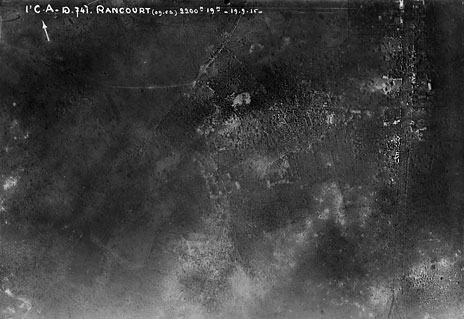
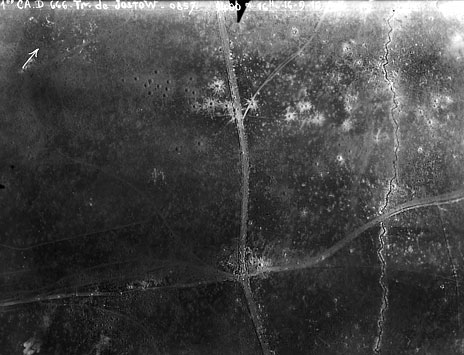

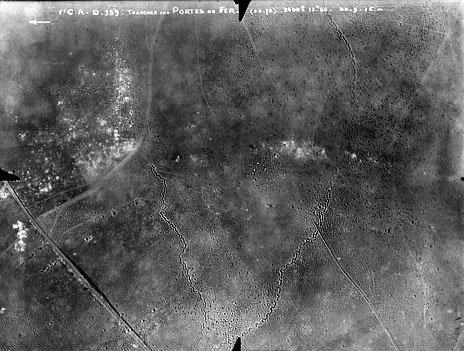
Aerial photos taken of Rancourt (19 Sept.), Tr. Jostow (14 Sept.), Tr. Negotin (28 Sept.), Portes de Fer (30 Sept.).
25 September: Execution of the Attack
Throughout the morning, the French bombardment intensified, with the 75s going into action around noon a tell-tale sign to that the infantry attack was soon to be launched. The din was so terrible that Laporte could no longer hear the person yelling into his ear next to him. 100 meters away, he watched as the German first line trench appeared to be literally blown up. Like the finale of a spectacular fireworks display, the French artillery opens up with its heaviest shells on the German reserve lines in the final minutes before l'heure-H. At 1234 hrs, the 1st wave goes over the top with tremendous élan along the entire regiment’s front, followed soon after by the 2nd, 3rd, 4th, 5th and 6th waves. Laporte was there:
A quick command is passed down: "Fix Bayonets!" We’re going to attack. The rain has stopped. The sun, as if to mark the occasion, suddenly appears. In the tumult of explosions, a bugle sounds the charge. We all leap out of our trenches to rush forward. Our machine-guns follow, carried in the arms of the men. It’s a marvelous sight to behold: all the way to Mont Saint-Quentin, as far as the eye could see, an entire line of poilus running across the sea of water and dodging around shell-holes with the sunlight glinting off their bayonets.Lieutenant Bourgoin in command of 10 Co. was in the first wave of the attack now surging across the flooded No-Man's-Land:
For the first time we left the trenches following a rolling artillery barrage, and in less than eleven minutes we had taken Rancourt, in which the defenders, literally exhausted and stupefied by our preparatory artillery fire, who looked like ghosts who had neither the time nor the energy to fight.The advance is made in perfect order with no stopping. Machine-guns placed on the Béthune Road open up on the flank but are unable to stop the general advance. The first objective is taken after only a few minutes. Soon the Bengale (Ruggieri) signal pots are spotted beside the Rancourt cemetery and at the southern entrance of Rancourt. Asp. L'Huillier wrote:After starting off with the first line lead by Sous-Lieutenant de la Ferrière, I turned back to see if our two sections of the second wave had set off well. With utter stupefaction I saw the artillerists in shirt-sleeves coming up behind us with their horses at the gallop, unlimber their guns, set up in battery, and begin firing! What great temerity it was for them to send their shells far enough out to cut off the approach route of the German reinforcements! The 61st RAC was truly an elite regiment that would finish the war with a red fourragère...
...It was a beautiful autumn day. We set off from our starting parallel towards Rancourt, behind a barrage of 75mm [shells] at a speed of 100 paces per minute, just like during our training exercise! We take the cemetery where the Boches had entrenched themselves. Heavy grenade fighting. We take the last resisters prisoner, threatening them with our bayonets. Some were holed up in actual vaults! Several men from my section fell in the action. My orderly [the griper Quegnies] was shot in the head behind me when we reached the northern edge of the village. Sadly, he was right to be afraid to go up to the line.We have to entrench as we are come under machine-gun fire. I received an order from a runner, from the lieutenant's PC, not to take any further action. The first battalion to our right suffered heavy losses and was unable to capture the eastern ruins of the village. We have to keep our heads down in a Boche trench until nightfall.
Losses are light. When a shell falls, the men can be seen moving away from the point of impact and then realign themselves once past it. It is an admirable sight. The progression of the regiment continues and it successively occupies its second objective and then its third around 1300 hrs. German 77 gun batteries, faced with waves of French soldiers bearing down on top of them, desperately tried to limber up and escape to the rear. Before they could, the artillerists and their horses were caught by the fire of the French 75s and were quickly cut down. The entrails of the horses were torn out and lay twisted on the ground like grisly tinsel.
As Laporte was approaching one trench a large young German officer raised a revolver at him. As the officer did so, Laporte discharged three shots from his own revolver at him. A bullet whistled past his ear just as the German threw out his arms and fell backwards. Upon seeing their officer fall, three Germans immediately left the trench and surrendered with their arms in the air. They joined hundreds of other prisoners who came flocking up to the men of the 151, hands held likewise up in the air, and were herded to the rear. The men immediately set themselves up in the newly conquered positions, constructing fire parapets and machine-gun positions. As the men went about their work, Laporte observed a grim episode unfold in the old No-Man’s-Land behind him.
The German batteries far away from our new lines, bombarded our rear with heavy caliber shells in order to block our reserves moving up. But it was the uninterrupted column of German prisoners who took all the fire intended for our troops. The day following this attack, piles of German corpses by the hundreds littered the resupply route, three-quarters of which lay in the water-filled shell-holes and would never be buried.
Meanwhile, the regiment's trench cleaners penetrate into the interior of Rancourt and surprise the defenders there, most of whom are taken prisoner at minimal loss to themselves. The prisoners are quickly directed to French lines without having to form a special guard to escort them.
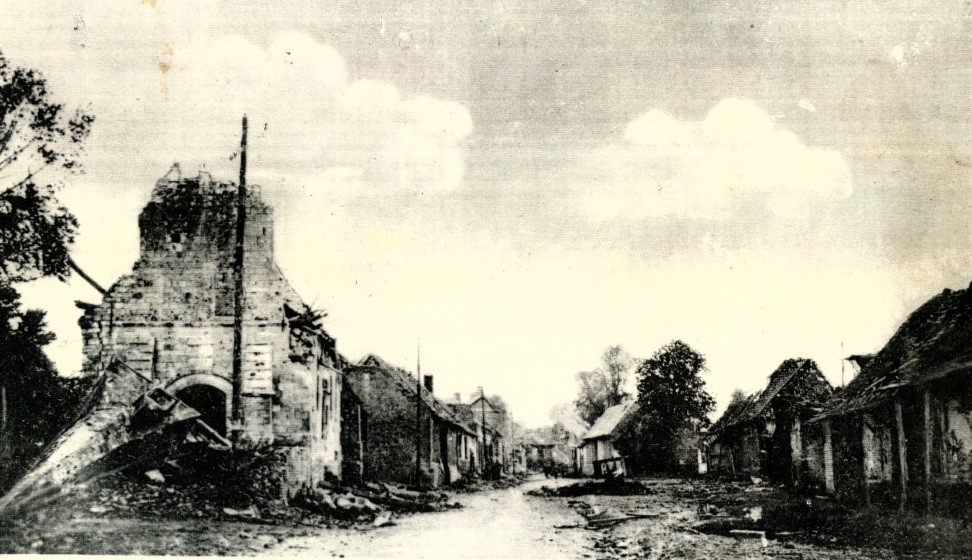
Village of Rancourt after the battle.
From his observation post, Moisson sees that the 94 RI is pinned down to the ground by German machine-gun fire coming from the southeast end of Rancourt, on the Béthune Road (Côte 139). At 1420 hrs, Moisson orders Cmdt. de la Ruelle (2 Bat.) to have one of his companies immediately face right in order to take the entire western part of the village situated on the Béthune Road and to ensure that the entire village is occupied. The maneuver also was intended to assist the 94 RI in retaking its advance. The order is executed by the 7 Co. at 1440 hrs.
At this moment, the disposition of the 151 is as follows: 1 Bat. occupies Tranchée 749 and the ammunitions shelters, where it links up with 3 Bat. holding the north and northeast exists of Rancourt. The 2 Bat. had closed up with the first two battalions (save 7 Co. which occupied Rancourt along the Béthune Road) up to the southern exit where it is unable to establish the liaison with the 94 RI. The southwestern exit of Rancourt was held by a fraction of the 3 Bat. commanded by Sous-Lieut. Lamothe de Mondion (11 Co.), comprised of a half-section, a 37 mm cannon, and a platoon of 3 MG Co. left at this spot by Capt. Adj. Major Delavaivre to hold the southwestern exit in order to link up with the 94 RI.
Meanwhile, the advance of the 127 RI on the left had been stopped almost as soon as it had departed from its lines by machine-guns placed near 0066. A 37 mm cannon battery is quickly set up by Capt. Antoine, which fires some shells in the immediate vicinity and the machine-gun fire is just as quickly silenced. This allows the 127 RI to retake its forward march. The 162 RI, which had closed up with the 151 during its progression, links up with 2 Bat. and closes an interval that had been created during the advance between the left of 1 Bat. and the right of the 127 RI. Already the 5 Co. was extending to the left of 1 Bat. A battalion of the 162 RI occupied Tranchée 748, in liaison with the 127 RI.
The 2 Bat. then passes through the 1 and 3 Bats. In order to continue onto its objective, Tranchée Négotin but the order is given to stop its movement due to the lack of forward progress of the 94 RI. At this moment, the enemy artillery opened up with powerful barrages to the north of Rancourt. It takes all the efforts of Cmdts. de la Ruelle and Cpt. Le Boulonger to stop a reflexive movement to the rear. The men were especially shocked to come under what they believed were short-falling fire of French 75s. The JMO made a point however to clarify that these were in fact German batteries of 75s set up in the village of Allaines to the south (more on this below). Bordinat was there when the 75s came raining down, killing and wounding some of the men. It was a significant blow to the morale of the men. While the seeming friendly-fire was occurring, Bordinat had his helmet shot off by a ricocheting bullet.
As night falls, the battalions go about reestablishing order and organizing the conquered positions. Moisson’s PC, which had been first set up in the Rancourt cemetery, is moved into a German dugout at Côte 750, at the northwest corner of the village in the sunken road running parallel to (west of) the Béthune Road.
A preparatory artillery barrage is opened on the enemy machine-guns position on the line 139 – 1561, in order to prepare the way for the attack on this ground by the 83 BI (southwest of Rancourt). A company of the 8 BCP reinforces the 94 RI and penetrates into Rancourt by the southwest. It tries to hook up with the 94 RI to the southeast but is unable to owing to the heavy enemy artillery barrage. This company will be put under Moisson’s command and be instructed to guard the southeastern exit of Rancourt. No further movements would occur this day. The men would spend a sleepless night in the seized German trenches and neighboring shell-holes in a high state of vigilance, expectant of an enemy counter-attack that would not come.
A note is included in the JMO stating that the 151 had performed magnificently, being the only unit in the 6e Armée that achieved such success.
Losses recorded for the regiment on 25 September differ between the JMO and other regimental reporting. The JMO states that there were 51 killed (incl. Capt. (Adj-Mjr 1 Bat.) Tison and Sous-Lieut. Collin) and 323 wounded (incl. Capt. Liethoudt and Baudin, Lieut. Bourgoin, Sous-Lieuts. Hucliez, Trannoy, Cormier, Hue, Lecomte), and 19 missing (for a total of 393). By contrast, troop returns in the regimental papers records 33 killed, 268 wounded, and 207 missing (a total of 508). Not mentioned in the JMO were the following officers being wounded: Capt. Marcel Olivier (who would dies of his wounds two days later), Sous-Lieuts. Hue, Bertrais, Baillat, and Moulin, and Chef d'Escq. (Cdt.) Lerval. For a day where losses were reported as "light," the 151 had lost nearly a quarter of its fighting strength in a matter of hours.

Map of Rancourt sector showing the ending positions of the 151 RI at 0200 hrs on 26 Sept. 1916, from the 151 JMO.
Order of Operations for 26 September:
I. British forces have taken a foothold in Gueudecourt and move to take Les Boeufs and Morval. The 1 CA has taken Frégicourt during the night and is still a good distance away from being able to attack the trenches of Portes de Fer. The 32 CA has taken Rancourt (151 RI) is itself a good distance away from being able to attack the Tranchée de Négotin and the Bois St.-Pierre-Vaast. The 5 CA has not been able to advance to the southern corner of the woods.
II. A general attack will be carried out on 26 September. On the left, 1 CA will attack the Boyau de la Chapelle and the trenches of Portes de Fer in order to seize Combles and to open a way towards Sailly-Saillisel. On the right, the 5 CA will attack the knoll of 2555, then the southeastern edge of Bois St.-Pierre-Vaast.
For the 42 DI, the first objectives of the attack on 26 Sept. are the Portes de Fer trenches and Tranchée Négotin, Côte 148, and the southwestern edge of the Bois de St.-Pierre-Vaast. To facilitate the progress of the 83 BI, the division will utilize the advantages afforded by the occupation of Rancourt. The attack will be launched from the north end of Rancourt while a frontal attack is being launched at the same time on the woods further on the right. The artillery preparation begins at daybreak. Effectively, the 151 RI which attacked north on 25 September will face right (east), shifting its battalions to attack east (the general direction of the French advance).
III. The 162 RI will consequently move up into the first lines occupied by the 151 between Tranchée 748 and the Arbre Signal on the Rancourt Road. Two battalions of the 151 RI (2 and 3 Bats.) are in the first line of attack with another battalion in support behind the right of the formation. Its mission is to close any interval that may result between the right of the 162 RI and the left of the 151 RI. It must strive to reach the line of Arbre Signal and 1566 by 1300 hrs. The left of the line will be reinforced in a manner that can effect a maneuver on the Tranchée de Bois de St.-Pierre-Vaast, from the north of Rancourt.
The other battalion (1 Bat.) of the 151 will ensure the security of the departure line and the village of Rancourt. It will guard principally the south of the village so that the 83 BI does not have to clear the enemy position to the south of the village. A company of the 162 RI which occupies the Tranchée Jostow will continue the fight using grenades. When this trench is cleared, it will remain in place in reserve of the brigade.
IV. As soon as the 1 Bat. is released by the 162 RI it will move to Rancourt to occupy the Béthune Road, facing east from the north entrance to the south entrance. It will relieve all elements of the regiment that it comes across and firmly install itself on the borders, establishing two solid advanced posts at the north and south entrances of the village. To do so it will be assisted by the Engineers Co. 6/3, a section of 6/3 bis, and a section of regimental pioneers. Machine-guns will be set up at these points and include a small garrison of troops.
As soon as the 2 and 3 Bats. are released by the 162 RI they are to occupy the successive positions as follows. The 2 Bat. on the left towards Arbre Signal in liaison to the extreme right with the right of the 162 RI. Machine-guns must in particular solidly hold this interval (Cmdt. de la Ruelle to ensure). Moreover, it must provide special support to its extreme left, in principle at least a half-company to close a gap between the two formations.
The right of the 2 Bat. will direct itself to point 1566 and gradually occupy half the space between Arbre Signal and 1566. The 9 Co. is put at the disposition of Cmdt. de la Ruelle (2 Bat.) to carry out the prescribed maneuver for the brigade on the Tranchée de St.-Vaast from the north of Rancourt. The 10 and 11 Cos. Remain under the orders of Capt. Adj. Major Delavaivre along with 3 MG Co. to try to occupy the right of the regiment’s departure line (Arbre Signal – 1566). The right strengthened at 1566 in close liaison with the 83 BI so as to allow it to facilitate as much as possible the progression of the 83 BI.
The 83 BI will continue to clear the ground south of Rancourt in attempt to place its lead elements prior to l’heure H on the line 1364 – Côte 140. The small group under by De Mondion and Nicot which occupies the southwest portion of Rancourt will rejoin its battalion once the 162 RI or all other troops have cleared it. Lieut-Colonel Moisson’s PC will be moved to a cellar on the Béthune Road at 1300 hrs, midway between the north and south entrances of Rancourt.
V. As the battalions gradually go into place, they are to quickly report to Lieut.-Colonel Moisson. They are under no circumstances to report with mentioning the liaisons they have, which is the principle point of the battle.
VI. At l’heure H (1600 hrs), the regiment will attack Côte 148 (on the Béthune Road) and the trenches on the southwest border of Bois St.-Pierre-Vaast, up to area of Côte 283 in liaison to the right with the 83 BI and in close liaison to the left with the 162 RI. This regiment has as its objective Tranchée Négotin.
VII. Same disposition of attack in the 2 and 3 Bats. as on 25 September, with the same foreign elements with the battalions. The 37 mm canon which is currently at the southwest entrance of Rancourt will rejoin the 3 Bat. Cmdt. Oblet (1 Bat.) will push up on the line Arbre-Signal – 1566 an element strong enough to hold this departure line when the two lead battalions go into the attack at l'heure H. All the while he must carefully keeping the necessary elements to hold in a secure fashion the eastern edge of Rancourt, including the north and south entrances of the village.
The men are to be immediately informed that the losses suffered from the 75 guns the day before were caused by cannons taken by the Boches and placed in the village of Allaines. These are not French guns firing on their own men as previously thought. The excellent maneuvering of the regiment on this day means it will act as the pivot for all other points of attack. A please is made to all officers to make their men aware of this and to ask of them this new effort, the consequences of which will have a serious impact on the enemy. Lieut-Colonel Moisson personally commends the fine spirit of the regiment and assures that those who deserve recognition will receive it. Already Capt. Carrère has been nominated by Moisson for the Chevalier de la Légion d’Honneur, along with two Médailles Militaires to others.
26 September: Execution of the Attack
At 1600 hrs, (l’heure H) the 2 and 3 Bats. launch their attack. A portion of 2 Bat. immediately comes under the fire of considerable number of machine-guns set up at Côte 148 to the north of Rancourt. The left of the battalion (along with the right of the 162) is also taken by an enfilade fire from Tranchée Négotin. The 3 Bat. (specifically 9 and 10 Cos. under Capt. Adj. Major Delavaivre) on the other hand advances in rapid bounds upon the border of Bois St.-Pierre-Vaast, leaving 11 Co. at 1566 with a section of machine-guns as an advanced post to protect the right of the regiment.
Despite the machine-gun fire, the 3 Bat., placed in re-entrant on the edge of the woods to the right of the seized objective (Tranchée du Bois St.-Pierre-Vaast), is able to take a foothold in the woods and to progress some ways into it. But as soon as it does, it’s right flank is threatened by an enemy envelopment. Lacking liaison on the right, it pulls back to occupy the seized trench.
During this time, through the combined efforts of the 162 and the 94 RIs, the enemy defenders of Tranchée Jostow (southeast of Rancourt) are pressed from all sides and are forced to surrender. The 37 mm canon of 3 Bat. placed at the south entrance of the village takes Tranchée Jostow by enfilade had caused much havoc in the morning and driving back a group that had remained in contact with the village.
The 7 Co., which was in connection with the 9 Co., had made it up to the Tranchée du Bois St.-Pierre-Vaast. However, it was unable to take the trench itself and remained pinned against the parapet after being subjected to an intense amount of grenades as well as machine-gun fire from Côte 148. Additionally, the barbed-wire in this part of the trench had not been destroyed by French artillery.
Meanwhile, the 94 RI has only managed to progress a short ways to the east of the Béthune Road. Under these conditions, the right of the 151 was entirely "in the air" and no troops were available to protect the right flank of the regiment. At 1740 hrs, two companies from the 154 RI are provided to Moisson by Colonel Deville (84 BI) in order to create a crenelated trench from 283 to the southeast entrance of Rancourt, passing by 1566.


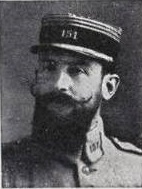
Left to Right: Capt. Adj. Major Paul Émile Delavaivre (KIA 26 Sept. 1916), Capt. Gelly, and Lieut. Jean Webanck.
During the attack, Capt. Adj. Major Delavaivre is killed after being shot in the forehead while observing the enemy to his extreme right from a shell-hole. Moisson instructs Capt. Gelly (commanding 3 MG Co.) to take command of 3 Bat. While waiting for orders to reach Capt. Gelly, Capt. St. Webanck who is commanding 11 Co. at 1566, receives orders to begin the construction of the trench until the two companies of the 154 RI arrive at nightfall.
Capt. Gelly later has a company of the 154 RI to relieve the 11 Co. at 1566, which then moves to the left of 283. He then has the second company of the 154 RI extend to the right of 11 Co. up to 1566. At this time, a detachment of the 8 BCP had advanced up to 1364 and thus assured the liaison with the 83 BI. The 151 RI will pass the night in this disposition, the enemy again choosing to not counter-attack.
In the evening of 26 September, Bordinat recalled being replaced by elements of the 3 Bat., with his company moving back into reserve in the village of Rancourt along the Bethune Road. They spend the day working hard on constructing a second line trench bordering the road, digging without let up under a broiling sun.
As was often the case, provisions were not reaching the new front lines, including water. The old familiar torture of thirst returned. Desperate searches were made to find a source of water. There was a pond nearby but the water was filthy and green. Moreover, the men were explicitly ordered to not drink the water in the fear that the Germans had poisoned the water, including the village wells. Even if this were not true, the profusion of poison gas the French artillery had dropped in the area surely made this a real risk. While Bordinat believe that there were surely more sources somewhere, the destruction caused by the artillery of both sides had so churned up and pulverized the land, that no sign of anything natural or man-made could be seen.
Eventually the scourge of dehydration -- ravaging thirst, racking headaches, burning fever -- became too much to stand. In desperation the men defied orders and took a drink from the dirty, scum-filled pond, pouring in a few drops of mint liqueur to help mask the nasty flavor.
…[T]he maintaining of a conquered position is always just as murderous if not more so than the attack. The enemy recovered, seeing our defensive works, was avenging his setback by furiously shelling us. We took shelter as best we could in our hastily dug trenches and constantly struggled to improve them as best as possible.
Late in the day, Bordinat’s trench came under threat of a rapid-fire 88 mm gun, with one of the shells exploding right in the middle of the trench, killing and wounding eight of his comrades. Bordinat himself is half-buried by earth and is badly "commotion," a term typically reserved at the time to refer to shell-shock. Calling for help, he is soon freed from the earth without a scratch on him but vomiting blood from his lungs.
Despite his misfortune, Bordinat countered himself lucky as he looked around the mangled bodies around him. Reporting to Capt. Bazailles, he was told to report back to the first-aid post, but Bordinat refused. Bazailles pleaded with Bordinat to return. To help convince him, he asked that he also escort back Adjudant Verreman, who’d been wounded in the eyes and was unable to see. Bordinat relented and began making his way back to the rear, though he had no idea where the first-aid post was located.
To recount the way I took would be impossible. Leading my unfortunate comrade by the hand, he begs me to move along as quickly as possible, moaning from his horrible wound, insulting me when I had to wait after the nearby explosion of shell, telling me that I must have lost my way, that I was going to get him killed, and that the journey was never-ending.
Bordinat estimated they traveled at least a mile. All of this was surely a severe test for Bordinat, who put on a brave face and patiently comforted the adjudant as best he could. He assured him that they would arrive at the first-aid post soon, that the doctor would take care of his wounds and make him better, and continually repeated: "We’ll be there in five minutes."
On this ravaged ground, ceaselessly beaten by gunfire, asking the shortest way of the rare person we encountered, always seemingly in pain and in a hurry, who responded evasively: "You’re headed the right way, keep going," or more often, "I have no idea, débrouillez vous [keep trudging on]!"
In short, at the end of the day this was the best system, this système 'débrouille'. So trudge on as best you can and with a little bit of luck, for it’s war.
At last, Bordinat arrives at the first-aid post, where he delivers his charge into the hands of the doctor. The adjudant, his face covered in blood, gives him a big hug, thanks him and wishes Bordinat all the best of luck. He sits down among the several other badly wounded men waiting to get bandaged and waits his own turn to be treated. When he is finally seen by the doctor, he is told there’s nothing that can be done for him there and is told to wait in an adjacent trench. The next day he will have to return back to the front line where he came from. Bordinat could only take comfort in the fact that the trench he now sheltered in was at least not under shell-fire.
In the JMO of the 151, the day’s operations were highly commended. The 162 RI had relieved the 151 RI in broad daylight while under an intense bombardment, and the 151 had transported itself (in the eastern part of Rancourt and the area to the east of the village) so that it could face its new objective situated to the northeast without a departure trench. This movement was executed despite the difficulties in a minimal amount of time and the attack launched at the precise time prescribed. Losses for the regiment on 26 September include 24 killed (incl. Capt.-Adj.-Major Delavaivre), 132 wounded (incl. Lieut. Guillot), and 9 missing.



Two photos showing bodies of French dead at Rancourt, most likely soldiers belong to the 151 RI. The third photo shows French troops advancing during the fighting on the Somme with a Bengale ground flare burning at center.
27 September: Orders from division are to continue the progression as soon as it is daylight in order to progressively take the entire edge of the Bois St.-Pierre-Vaast and penetrate some distance into the woods itself. From its end, the 162 RI must take a portion of the Portes de Far trenches and the Tranchée Négotin at 1530 hrs. The Côte 148, being the junction between the attack on the woods and that of the Portes de Fer, must in particular be attacked in order for the operations to be successful.
Despite powerful artillery preparations, the enemy machine-guns on Côte 148 weren’t impacted enough and the fire unleashed from these checked any French advance. Despite all its efforts, the 2 Bat. could progress only 30 meters towards the woods and Côte 148. The same was true with the 162 RI. To the right, the 8 BCP moved up to a point level with the second company of the 154 RI, 100 meters from it. Asp. L'Huillier recorded:
Meanwhile, back in the support lines by the first-aid post, Bordinat had tried to get some rest as best he could. Early the next morning Bordinat started back up to the front line trench his company still held, not saying a word to anyone. Bordinat took strange comfort in the fact that at least there they had the filthy green water of the pond to drink, whereas at the first-aid post there was absolutely nothing -- the wounded suffering and dying with no food or water. He reported back to Capt. Bezailles and recounted his story. His commander congratulated him on making it back and said he would recommend him for the Croix de Guerre for his actions.Very bad weather conditions. The 61st Artillery Regiment's second-lieutenant observer, passing by my section, told me he could not distinguish the enemy's positions and regulate the batteries fire. At 1000 hrs in the pouring rain, we bound forward another 200 meters. We capture prisoners. I lose 3 men including one killed. The order is given to me to fall back and regroup in the enemy trenches conquered the day before. We have not received any supplies for three days. We are running out of reserve food.
Over the course of the next several days, Bordinat would help to coordinate resupply parties, which had to travel back several kilometers to Maurepas and Le Forest, stumbling over and into shell-holes the entire way. And what they brought back was liquor, wine, and loaves of bread with a few pieces of meat that got coated with dirt and dust along the way.
Losses for the regiment on 27 September include 19 killed (incl. Sous-Lieuts. Mollet, Blondeau, and Suisse), 84 wounded, and 11 missing. By now, regimental records indicates the regiment's total effective has been reduced in one week by nearly half, with only 1,040 troops remaining.
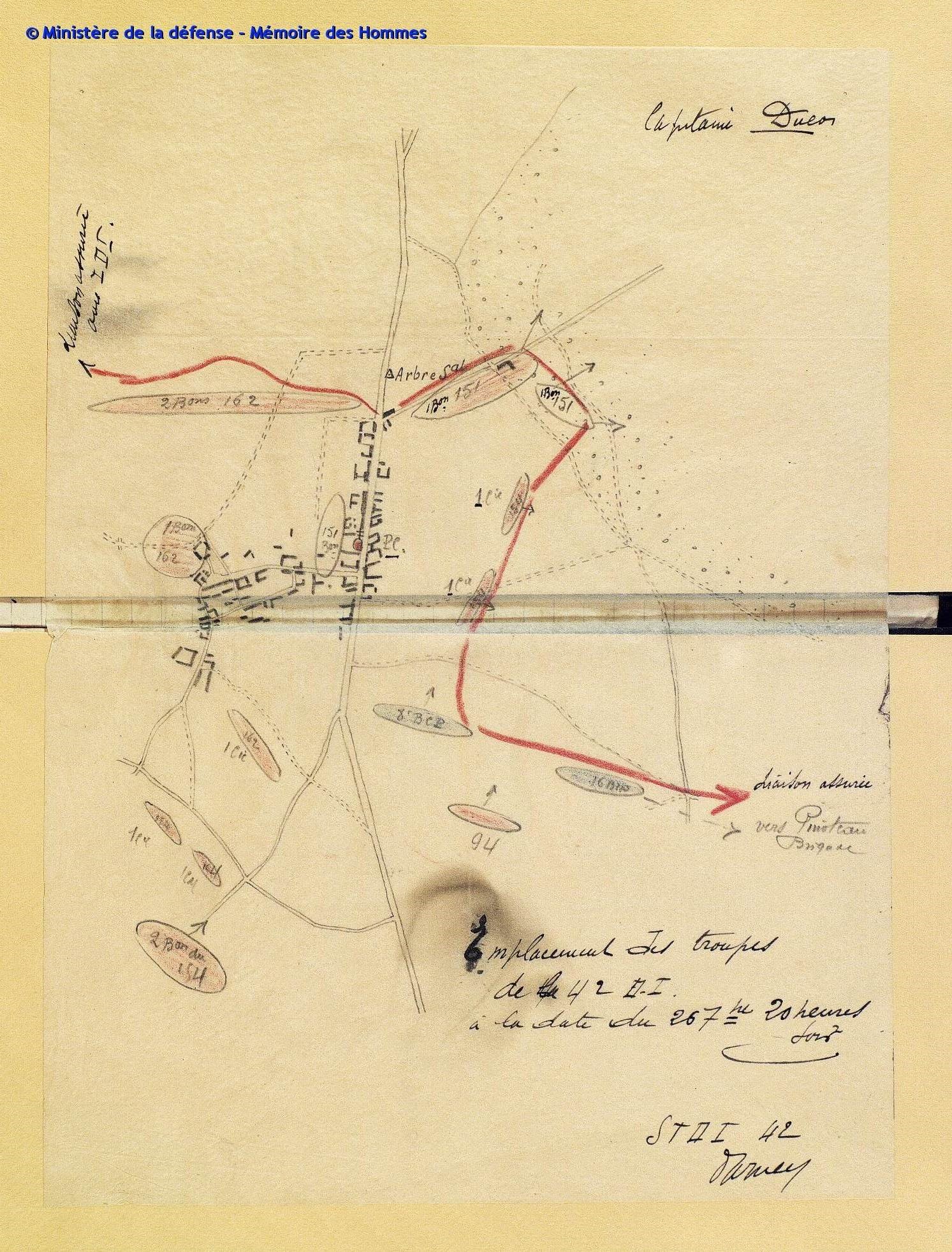
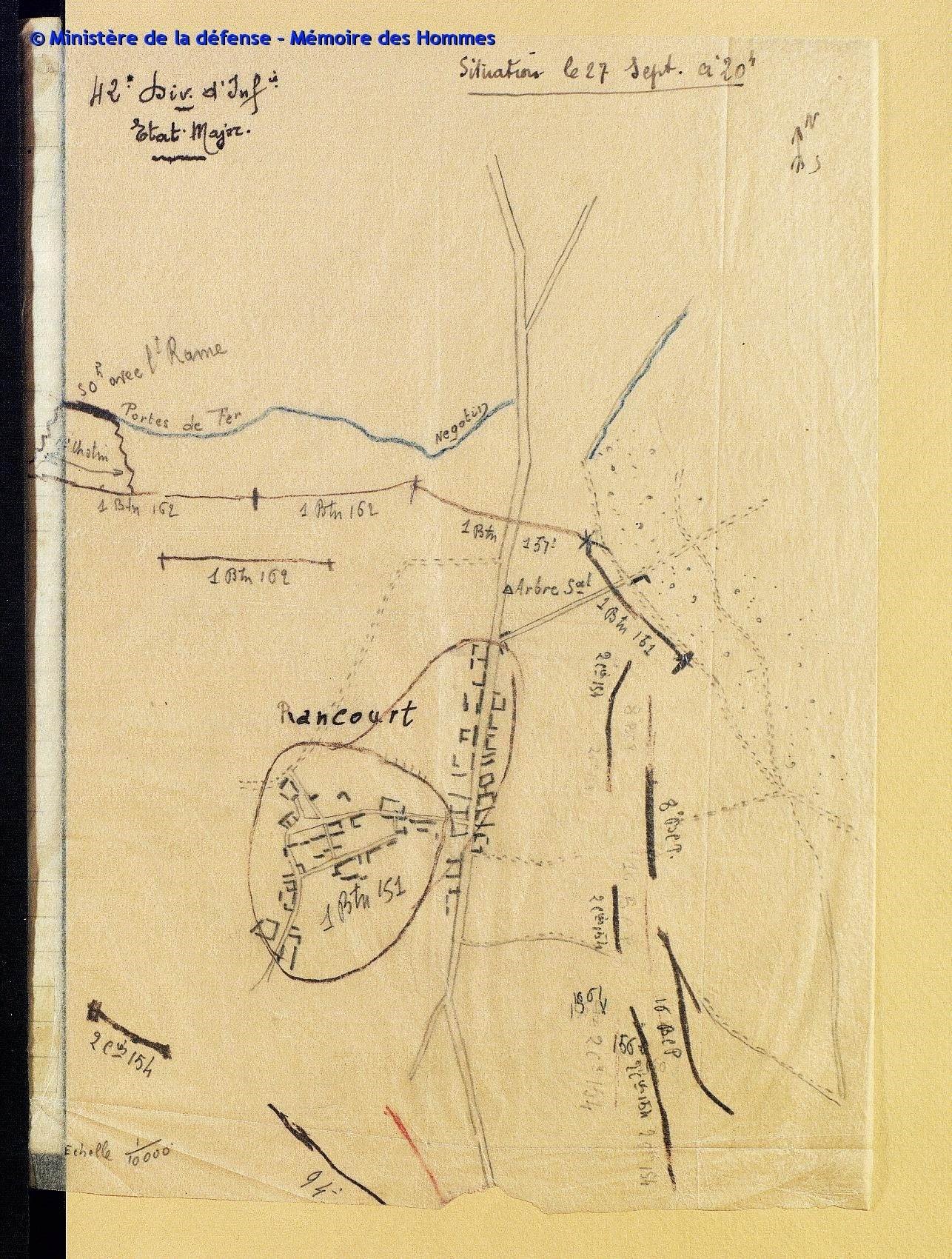
Left: Map of Rancourt sector showing positions of 42 DI on the evening of 27 Sept. 1916 (JMO of the 32 CA). Right: Map of the Rancourt sector showing the gains made French forces as of 28 Sept. 1916 (source: JMO of the 125 DI).
28 September: German artillery heavily bombards the regiment’s first lines, especially the village of Rancourt. L'Huillier's mood was increasingly darkening.
During the night, the remaining elements of 2 and 3 Bats. and their machine-gun companies are relieved by a battalion of the 154 RI, which takes over the sector from the Béthune Road to the north of Rancourt up to Côte 283. After the relief, the 2 and 3 Bats. are bivouacked in the small wood 1 km south of Le Forest where they pass the night.Heavy rain. We are stuck in the mire. The shell-holes are filled with water and, with their canteens being empty, several poilus drink it! Total calm along the whole front. The Boches must be suffering from the bad weather as much as we are. But they are holed up in deep shelters.
29 September: The 2 and 3 Bats. move to the Ferme Bronfay south of Maricourt where the board trucks in the morning to be transported to rest Camp No. 12 in Bois des Célestins (just north of the hamlet of Chipilly). Here the men are lodged in wooden barracks constructed by engineers. The 1 Bat., which had remained in the sector as the garrison force of Rancourt, is relieve at night by a battalion of the 154 RI and bivouacs in the small wood south of Le Forest. Capt. Le Boulanger takes command of 3 Bat. and Capt. Gelly retakes command of the 3 MG Co.
During the eight days that the 151 had been at the front, a total of 610 men were killed or wounded. Nearly 400 of these were suffered when the regiment attacked on the 25 September. Given the reduction in the effective of a French infantry regiment, this represented a loss of over 20% of the 151's total effective. These losses were considered to be light, not just by commanders but the men themselves, which speaks pointedly to the just how bloody fighting was in the Great War. But the 151 had something to show for it, especially when contrasted to the black day on the same date one year before. The 25 September 1916 was the same day to the year as their bloody assault in the mournful plains of Champagne in 1915. This time however the story had been much different. The regiment had advanced over a mile, seizing multiple lines of enemy trenches and taking hundreds of prisoners in the process. For its accomplishments, the 151 received its first citation in the Orders of the Army (6th) No. 436, which read:
"Elite division which has played the most glorious part in all the most important operations of this campaign -- the Marne, the Yser, the Argonne, Champagne, Verdun -- under the energetic direction of General Deville, came to give, in September 1916, new demonstrations of its offensive spirit and brilliant maneuvering abilities on the Somme, in taking strongly organized and bitterly defended positions. The 8th, 16th B.C.P., the 94th, 151st and 162nd Infantry Regiments have acquired new titles of glory."The 151 had also earned the moniker of the "Rancourt Regiment".





